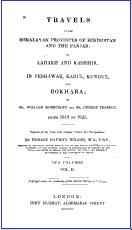Travels in the Himalayan Provinces of Hindustan and the Panjab; in Ladakh and Kashmir in Peshawar, Kabul, Kunduz and Bokhara: From 1819 to 1825 (2 volumi) Moorcroft William - Trebek George
| |||||||||||||||||
|
Editeur - Casa editrice |
O.U.P | ||||||||||||||||
|
Città - Town - Ville |
Oxford | ||||||||||||||||
|
Anno - Date de Parution |
1841 | ||||||||||||||||
|
Lingua - language - langue | eng | ||||||||||||||||
|
Ristampa - Réédition - Reprint |
Andesite Press (2017) | ||||||||||||||||
|
|
|||||||||||||||||
|
|
|
I viaggi avventurosi di due esploratori inglesi aldilà dell'Himalaya. Moorcroft scopre i segreti della tessitura della pashmina e porta in Inghilterra i sistemi di lavorazione del "cachemere".
Recensione in altra lingua (English): |
| William Moorcroft was a veterinary surgeon to the Bengal army. He was particularly interested in improving the stud by importing Turcoman horses and to this end he wished to investigate the possibilities of trade across the Himalayas. In 1811 he was the first Westerner to cross the Himalayas. In the subsequent expedition reported here, he ventured into Ladakh where he spent several months. Having failed to get permission to enter Chinese Tartary he traveled to Kashmir where he made a thorough investigation pf the shawl industry and then subsequently Kabul and Bokhara where he "met with as much kindness from the king as could be expected from a selfish, narrow-minded bigot." He was accompanied by George Trebeck. Both Moorcroft and Trebeck died on the return journey from Bokhara but their papers reached India and were subsequently edited and published by Wilson in 1841. | |||||||||||||
| Recensione in lingua italiana | |||||||||||||||||
|
From 1790 to 1791 the surgeon William MOORCROFT studied veterinary medicine in Alford. He was the first Englishman with a complete formal veterinary education. In 1808 he gave up his horse practice and went into service of the East India Company as superintendent of the Company's Indian stud. Search for appropriate stud-horses and his efforts for opening up trading-routes from India to inner Asia induced him to exploring expeditions into the regions of the southwest Himalayas, the Hindu kush, Samarkand and Afghanistan. There he made also a lot of geographical and biological observations. He was not only one of the European pioneer Himalaya explorers but became also an early participant of the later so called "Great Game", the struggle between England and Russia for supremacy in Central Asia. | |||||||||||||||||
| |||||||||||||||||



 Travels
Travels